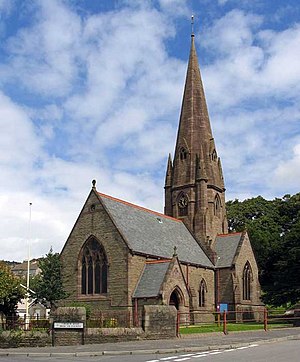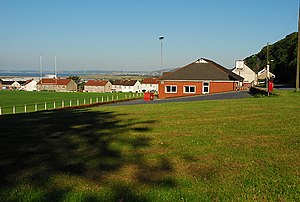Baglan
| Baglan | |
| Glamorgan | |
|---|---|

| |
| Location | |
| Grid reference: | SS746924 |
| Location: | 51°36’60"N, 3°48’41"E |
| Data | |
| Population: | 6,654 (2001[1]) |
| Post town: | Port Talbot |
| Postcode: | SA12 |
| Dialling code: | 01639 |
| Local Government | |
| Council: | Neath Port Talbot |
| Parliamentary constituency: |
Aberavon |
Baglan is a village in Glamorgan situated between Port Talbot and Neath. The village is named after Saint Baglan (earliest reference is to 'Bagelan' and dates from 1199).[2]
Baglan is located on the side of a steep hill and is surrounded by two main hills, Mynydd-y-Gaer (to the north) and Mynydd Dinas (to the east). The moors and Baglan Bay are to the south-west. The village contains a number of historical buildings such as Baglan House, St Catharine's Church, and St Baglan's Church. The first, St Baglan's Church is now a shell after a fire in 1954. St Catharine's Church was designed by John Prichard, an exponent of the neo-Gothic style and dedicated in 1882. Baglan House was one of the seats of the Villiers family, earls of Jersey.[3]
To the south east of the village lie industrial areas called Baglan Moors and Baglan Bay.
The village has a railway station on the South Wales Main Line with trains to Cardiff & Swansea.
Early History

The earliest evidence of settlement here dates back to the Bronze Age with there being a tumulus called Twyn Disgwylfa on Mynydd Dinas and a round barrow within the hillfort of Buarth-y-Gaer.[4] There are is also an Iron Age hillfort on the surrounding hill called Mynydd-y-Gaer.[5] The Roman road (Via Julia) very possibly passed through the village, although the statement that there was once a Roman milestone at the junction of Old Road and Albion Road Approach is erroneous (the milestone in question is actually from Pyle).[6] Later, a Dark Age (Early Christian period) church was founded here, as can be seen from a few local Early Christian stones, especially the Cross of Brancu (dated 9th - 10th century) which is in the vestry of St Catharine's church. The inscription on the Cross of Brancu(f) could be a dedication to Brancuf,[7] or reads as Brancu f(ecit).[8] i.e. was made by Brancu or may be Brancu followed by a chi-rho monogram.[9] (the name Brancu is preceded by a simple Latin cross in any case). According to tradition the church was founded by the aforementioned St Baglan.
In the mediæval period, the church (dedicated to St Baglan) was rebuilt seemingly on the same site.[10] The church burnt down in 1954 although ruins still exist at the top of the churchyard of St Catharine's church. There were two mediæval castles within the parish boundary.[11] The first is a motte castle on Mynydd Dinas called 'Castell Bolan'. The motte is now covered in trees (and not readily accessible) and is much closer to the village of Cwmafan than to the village of Baglan. The other is closer to Baglan and is known by the name 'Plas Baglan'. This is sited above the Baglan Brook and is heavily overgrown (and not readily accessible). Although more usually thought of as a manor house than a castle, it is a "strongly fortified site, a castle rather than a moated site ... a masonry castle that existed by the 13th century".[12] It did, however, become a manor house and had literary associations in the 15th & 16th centuries. Several house platforms from the mediæval period also exist on the hills behind the village.[13]
Sport

Baglan is home to four sporting associations; Baglan Rugby Football Club, Baglan Football Club, Baglan Cricket Club and Tyn-Y-Twr Bowling Club.
People
- Michael Williams, who was created Baron Williams of Baglan, of Neath Port Talbot in Glamorgan on 23 July 2010.[14]
| ("Wikimedia Commons" has material about Baglan) |
Notes
- ↑ Lead Key Figures
- ↑ The Oxford Names Companion (2002), Oxford University Press, p925. ISBN 0-19-860561-7
- ↑ The Welsh Academy Encyclopedia of Wales. Cardiff: University of Wales Press 2008
- ↑ Royal Commission on Ancient and Historical Monuments in Wales (1976), An Inventory of the Ancient Monuments in Glamorgan Volume I Part I, HMSO, p81. ISBN 0-11-700588-6
- ↑ Royal Commission on Ancient and Historical Monuments in Wales (1976), An Inventory of the Ancient Monuments in Glamorgan Volume I Part II, HMSO, pp 26, 46 & 55. ISBN 0-11-700589-4
- ↑ A L Evans (1970), The Story of Baglan, published by the author, p18
- ↑ V. E. Nash-Williams (1950), the Early Christian Monuments of Wales, University of Wales Press, p130.
- ↑ Royal Commission on Ancient and Historical Monuments in Wales (1976), An Inventory of the Ancient Monuments in Glamorgan Volume I Part III, HMSO, p43. ISBN 0-11-700590-8
- ↑ A L Evans (1970), The Story of Baglan, published by the author, p21
- ↑ P R Davies & S Lloyd-Ferne (1990), Lost Churches of Wales & the Marches, Sutton, p30, ISBN 0-86299-564-7
- ↑ Royal Commission on Ancient and Historical Monuments in Wales (1991), An Inventory of the Ancient Monuments in Glamorgan Volume III Part 1b, HMSO, p135
- ↑ Royal Commission on Ancient and Historical Monuments in Wales (1991), An Inventory of the Ancient Monuments in Glamorgan Volume III Part 1b, HMSO, p149
- ↑ Royal Commission on Ancient and Historical Monuments in Wales (1982), An Inventory of the Ancient Monuments in Glamorgan Volume III Part II, HMSO, p32, ISBN 0-11-701141-X
- ↑ London Gazette: no. 59501, p. 14415, 28 July 2010.
